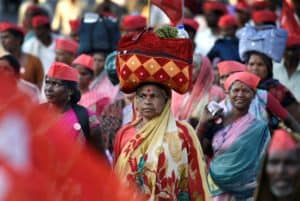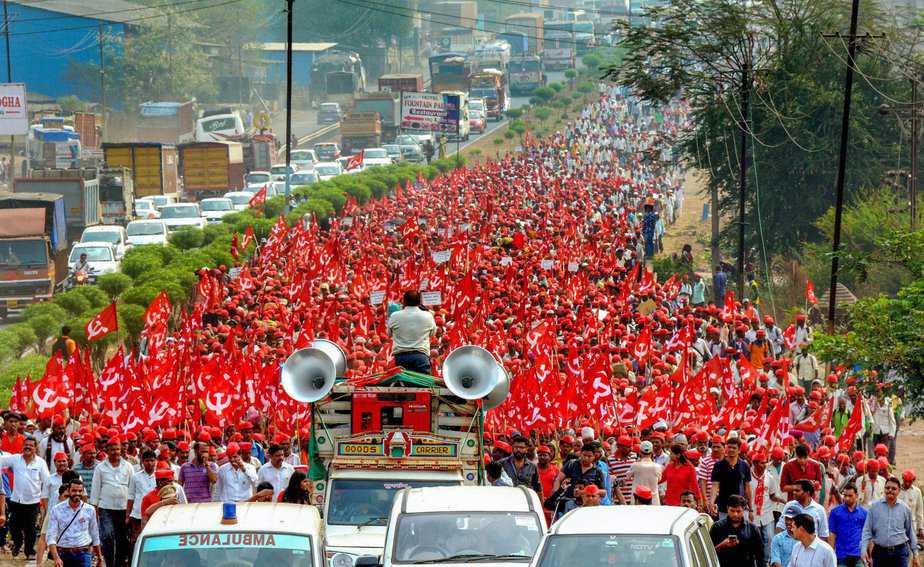The 180-km march generated much noise across the world and hassled the BJP government into accepting major demands within hours of the rally reaching Mumbai.
A week-long Gandhian march by the farmers of Maharashtra in the scorching sun under the banner of a Left party — blisters on foot, bleeding toes, broken slippers and their decision to complete the final walk into the financial capital at midnight so as to not disturb the city’s residents — won the heart of everyone, leading to a huge outpouring of support on social media.
The distressed farmers’ peaceful way of seeking their long pending dues and the support they received from people eventually paid off with the state’s BJP government forced to quickly accept most of their demands.
After the first meeting with the farmer leaders of the All India Kisan Sabha, the farmers’ wing of the Communist Party of India (Marxist), on Monday afternoon, the Fadnavis government announced it has accepted all major demands and stipulated a deadline for each “in writing”. The promises are likely to be tabled in the legislature on Tuesday.
The Left leaders called off the stir, prompting the government to make arrangements to pack off the farmers by trains and buses to avoid any further embarrassment should they return on foot.
Interestingly, the government had remained a mute spectator till Sunday, not making a serious effort to reach out to either the farmer leaders or the CPI(M), which had organised the march.
The farmers’ demands primarily included proper implementation of a farm loan waiver scheme, adequate compensation to all farmers whose crops had failed, rolling back of forcible land acquisition, implementation of the Swaminathan Commission’s recommendations (mainly the fair and remunerative price to be 1.5 times the input cost), land rights to forest dwellers and a Rs 2,000 monthly pension to all marginalised farmers above the age of 60.
All of them are old issues and have been raised by farmers for many years under different banners. The recent crop failure and poor returns made them more anxious, angry and distressed. Suicides have continued despite the announcement of a massive loan waiver worth Rs 34,000 crore in June.
The saffron government perhaps assumed that the movement led by CPI(M) won’t make much of a dent, considering the Left’s rather small base in the state. The BJP’s miscalculation turned out to be a victory for the CPI(M) which has just one MLA in the 288-member Assembly. The protest was significant and it influenced the government to present yet another “farmer-friendly” Budget for 2018-19 on Friday.
Other parties were more clever than the BJP. Alliance partner Shiv Sena and Opposition parties — the Congress, the Nationalist Congress Party and the Maharashtra Navnirman Sena — extended wholehearted support to the farmers, their core voter base. The general elections and Maharashtra Assembly elections are not far away and the farmers hold the key.
“Laal salaam ko bhagwa salaam (a saffron salute to red salute),” said Eknath Gaikwad, the minister of PWD (projects), with a big smile as he shared the dais with Left leaders, including Sitaram Yechury, who flew in from Delhi, after the demands were met.
The government has promised to clear the backlog of agrarian loans pending since 2001. Men and women in the same family will get waiver benefits as per the agreed formula. The government has also promised to clear, within six months, all pending cases of individual and community land rights of tribals under the Forest Rights Act. The government has also committed to setting up a state commission to decide on the fair and remuneration price for agri products. The government has also pledged to complete the ambitious River Linking Project within four years to ease unirrigated areas that account for over 80% of the state’s total farmland.

The stipend under the Sanjay Gandhi Niradhar Yojna Pension will also be hiked. To decide on milk cost, the government has promised to set up a separate committee to consider the 70:30 formula.
Variety of issues
Prathamesh Gaikwad (56), a farmer from Jalna district who was part of the march, defaulted on the repayment of a bank loan worth Rs 1 lakh due to low production and poor returns last year. Having failed to secure his dues even after nine months, Gaikwad joined the protest. The Fadnavis government’s announcement now entitles him to a full waiver.
Somnath Wagh and 85 other villagers, also from Jalna, joined the stir to oppose the forcible land acquisition by the state to build the Samrudhi corridor, an expressway between Nagpur and Mumbai.Tribals too were part of the agitation, hoping to get rights to land they have tilled for generations.
Poor implementation of loan waiver scheme
Most farmers in Maharashtra are yet to receive the benefit announced under the loan waiver scheme that was to waive off loan defaults up to Rs 1.5 lakh.
At the time of the scheme’s announcement, 8.9 million farmers were expected to benefit and the burden on the exchequer was expected to be Rs 34,000 crore.
By the end of January, only 3.1 million farmers have got their due, totalling Rs 12,200 crore, government data, accessed by Newslaundry, says.
Poor planning and glitches in preparing beneficiary database have been cited as the prime reasons for the delay apart from a lack of political will. A few nationalised banks have also been accused of inflating the bills and including a large number of bogus names, forcing the government, as a result, to deliberately go slow.
Shrinking agriculture economy drawing low growth rate
Crop failures and poor market price are the prime reasons behind the anger boiling over among the small and marginal farmers. Besides, Vidarbha and Marathwada regions of the state have seen an unprecedented devastation of BT cotton crop due to pink-worm attack — government’s estimates hover between 30% and 70% in various districts. Maharashtra is a major cotton producer.
In 2016-17, Maharashtra’s farm sector grew, riding on a good monsoon and bumper harvests, by 22.5%, pushing its overall growth to 10% despite the preceding years of drought and demonetisation. In 2017-18, the farm economy contracted 8.3%, the Economic Survey said, owing to a weak monsoon and growing distress which brought down the state’s overall economic growth to 7.3%.
To make matters worse, the Survey predicted, the production of cereals, pulses, oilseeds and cotton is expected to decrease this year by 4, 46, 15 and 44 per cent, respectively, while the production of sugarcane crop would increase by 25% over the previous year.
Agrarian share in economy dips
The share of “agriculture & allied activities sector” in the state economy, according to the Economic Survey, stood at 12.2% as against 15.3% in 2001-02. These were the years of a high incidence of farmer suicides.
A steady reduction in the average size of land-holding is also touted as a major reason why agriculture has become unviable. In 1971, Maharashtra had an average land holding of 4.28 hectares. Today, it stands at 1.44 hectares. In other words, 78% of the state’s 13.7 million farmers are small and marginal.





